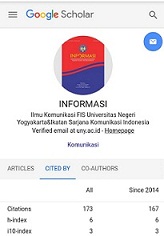Social media and virtual sisterhood: The Instagram account @perempuanberkisah as a space for women's solidarity
DOI:
https://doi.org/10.21831/informasi.v53i2.63994Keywords:
Instagram, social media, solidarity, women, virtual sisterhoodAbstract
The practical and interactive nature of social media has played a pivotal role in fostering unity among women. Social media has evolved into platforms for women to express their worries, share their fears, discuss their problems, and be more emphatetic towards each other. In this virtual realm, a distinct form of solidarity has emerged, allowing women to amplify their voices beyond the confines of the non-virtual world. An exemplary illustration of this phenomenon is the Instagram account @perempuanberkisah, which actively advocates for women's issues, particularly focusing on cases of violence. @perempuanberkisah curates diverse content, frequently featuring themes related to violence, including posts tagged #kisah18+ and #triggerwarning. Notably, the content goes beyond mere storytelling; it includes ongoing support for the individuals sharing their experiences, both from the @perempuanberkisah team and the broader community of women, as evidenced by the supportive comments flooding the posts. This study aims to delve into the virtual solidarity that has taken root among women within the @perempuanberkisah community, particularly within the context of contents labelled #kisah18+ and #triggerwarning. This research uses the virtual etnography method with descriptive-critical analysis. The result shows that virtual solidarity emerges from the empathy shown by @perempuanberkisah and women on Instagram through almost the entirety of their content. The sense of belonging and shared experience have generated solidarity among women despite the lack of interactions beyond the virtual space.
References
Alfaro, M. J. V., & José, M. (2020). Feminist Solidarity Networks Have Multiplied since the COVID-19 Outbreak in Mexico. Interface: A Journal on Social Movements, 12(1), 82-87 http://www.interfacejournal.net/wp-content/uploads/2020/05/Ventura-Alfaro-1.pdf
Annur, C. M. (2021, June 29). Pengguna instagram di indonesia mayoritas perempuan. Katadata. Accessed from: https://databoks.katadata.co.id/datapublish/2021/06/29/perempuan-paling-banyak-gunakan-instagram-di-indonesia.
Bandura, A. (2000). Exercise of Human Agency through Collective Efficacy. Current Directions in Psychological Science, 9(3), 75–78. doi: 10.1111/1467-8721.00064
Benkler, Y. (2006). The Wealth of Networks: How Social Production Transforms Markets and Freedom. New Haven and London: Yale University Press.
Bennett, W. L., & Segerberg, A. (2012). The Logic of Connective Action: Digital Media and The Personalization of Contentious Politics. Information, Communication & Society 15(5), 739–768.
Blithe, S. J., & Neal, M. (2021). Communicating Gender Advocacy: Riding The Fourth Wave of Feminism, The Routledge Handbook of Gender and Communication (pp. 570-584). London: Routledge.
Bossio, J., & Diez, I. (2021, August 22). Women's Solidarity and Social Media: Sisterhood Concept in #LasRespondonas, a Facebook Group in Peru. arXiv.Org. https://arxiv.org/abs/2108.09761
í‡ela, E. (2015). Social Media as a New Form of Public Sphere. European Journal of Social Sciences Education and Research, 4(1), 195. doi: 10.26417/ejser.v4i1.p195-200
Dahlgren, P. (2013). The Political Web. England: Palgrave Macmillan.
Dayal, M., & Chaudhry, N. (2017). Social Media & Women: A Twist in the Tale. IOSR Journal of Humanities and Social Science, 22(9), 10–17.doi: 10.9790/0837-2209161017
Dijck, J. V., & Poell, T. (2015). Social Media and the Transformation of Public Space. Social Media + Society, 1(2). doi: 10.1177/2056305115622482
Fahadi, P.R. (2022). Social Media Advocacy for Gender Equality by Indonesian Men: The Case of Aliansi Laki-laki Baru (New Men's Alliance). Asiascape: Digital Asia, 9(3), 302-333. doi: 10.1163/22142312-bja10036
Fisse, T., & Hass, C. (2020). Covid-19 and True Solidarity on the Internet. The Annual Magazine on Internet and Society Research, 154-160. doi: 10.5281/zenodo.3753034
Fuchs, C. (2014). Social Media: A Critical Introduction. London: Sage.
Gravel-Party, F. (2021, Jul 27). "Instagram therapy" and how women use social media for mental health support, solidarity. The Conversation. Accessed from: https://theconversation.com/instagram-therapy-and-how-women-use-social-media-for-mental-health-support-solidarity-164448.
Habermas, J. (1992). The Structural Transformation of The Public Sphere: An Inquiry Into a Category of Bourgeois Society. Cambridge, MA: The MIT Press.
Habermas, J. (2015). The Structural Transformation of The Public Sphere. New York: Polity Press.
Jati, W. R. (2016). Cyberspace, Internet, dan Ruang Publik Baru: Aktivisme Online Politik Kelas Menengah Indonesia. Jurnal Pemikiran Sosiologi, 3(1), 25. doi: 10.22146/jps.v3i1.23524
Jenkins, H., Camper, B., Chisholm, A., & Grigsby, N. (2009). From Serious Games To Serious Gaming. In Serious Games. London: Routledge.
Jenkins, H., Ford, S., & Green, J. (2013). Spreadable Media. New York: New York University Press.
Kozinets, R. V. (2012). Marketing Netnography: Prom/ot(Ulgat)ing a New Research Method. Methodological Innovations Online, 7(1), 37–45.doi: 10.4256/mio.2012.004
Kozinets, RV (2010). Netnography: Doing Ethnographic Research Online. London: Sage Publications.
Kristianto, K., Ramadhan, A. B., & Marsetyo, F. D. (2021). Media Sosial dan Connective Action: Studi Kasus Penggunaan Twitter sebagai Ruang Solidaritas Selama Pandemi COVID-19. Journal of Social Development Studies, 2(1), 1–13. doi: 10.22146/jsds.1037
Kumari, M. (2020). Social Media and Women Empowerment. International Journal of Scientific & Technology Research, 9(3), 626-629. https://www.ijstr.org/finalprint/mar2020/Social-Media-And-WomenEmpowerment.pdf
Livingstone, S. (2003). The Changing Nature of Audiences: From the Mass Audience to the Interactive Media User. In A Companion to Media Studies (pp. 337–359). doi: 10.1002/9780470999066.ch17
Livingstone, S. (2013). The Participation Paradigm in Audience Research. The Communication Review, 16(1–2), 21–30. doi: 10.1080/10714421.2013.757174
Loiseau, E., & Nowacka, K. (2015). Can Social Media Effectively Include Women's Voices in Decision Making Process?. Issues Paper. OECD.
Lubis, E. E. (2014). Potret Media Sosial dan Perempuan. Jurnal Parallela, 1(2), 89-167, ISSN: 2356-2196
Marlina, I. (2018). Paham Gender melalui Media Sosial. Habitus: Jurnal Pendidikan, Sosiologi dan Antropologi, 2(2), 225-242. doi: 10.20961/habitus.v2i2.28800
Maryani, E. (2018). Developing Social Solidarity through Digital Media. Jurnal Komunikasi Ikatan Sarjana Komunikasi Indonesia, 3(1), 12-17. doi: 10.25008/jkiski.v3i1.144
Meyrowitz, J. (1985). No Sense of Place: The Impact of Electronic Media on Social Behavior. Oxford, UK: Oxford University Press.
Negt, O., & Kluge, A. (1972). Offentlichkeit und Erfahrung. Zur Organisationsanalyse von € Burgerlicher und Proletarischer € Offentlichkeit € . Frankfurt am Main: Suhrkamp.
Ojeda, N. S. (2013). "Cárcel de mujeres". Una mirada etnográfica sobre las relaciones afectivas en un establecimiento carcelario de mediana seguridad en Argentina. Sociedad y Economía, (25), 237-254. Accessed from: http://www.scielo.org.co/scielo.php?script=sci_arttext&pid=S1657-63572013000200011&lng=en&tlng=es.
Papacharissi, Z. (2002). The Virtual Sphere: The Internet as a Public Sphere. New Media & Society, 4(1), 9-27. doi: 10.1177/14614440222226244
Papacharissi, Z. (2010). A Private Sphere: Democracy in a Digital Age. Malden, MA: Polity Press.
Parahita, G. (2019). The Rise of Indonesian Feminist Activism on Social Media. Jurnal Komunikasi Ikatan Sarjana Komunikasi Indonesia, 4(2), 104-115. doi: 10.25008/jkiski.v4i2.331
Perempuan Berkisah (2021, Jun 26). Accessed from: https://www.instagram.com /perempuanberkisah.
Prajarto, N. (2018). Netizen dan Infotainment: Studi Etnografi Virtual pada Akun Instagram @Lambe_Turah. Jurnal Ilmu Komunikasi, 15(1), 33-46. doi: 10.24002/jik.v15i1.1367
Schuler, D., & Day, P. (2004). Shaping The Network Society: The New Role of Civil Society in Cyberspace. Cambridge, MA: The MIT Press.
Shirky, C. (2008). Here Comes Everybody: The Power of Organizing Without Organizations. New York: Penguin Press.
Shirky, C. (2011) The political power of social media. Foreign Affairs, January/February 2011. Accessed from: http://www.foreignaffairs.com/articles/67038/clay-shirky/the-politicalpower-of-social-media
Smith, L. G. E., Thomas, E. F., & McGarty, C. (2015). "We Must BE the Change We Want to See in the World": Integrating Norms and Identities through Social Interaction. Political Psychology, 36(5), 543–557. http://www.jstor.org/stable/43783883
Stewart, M., & Schultze, U. (2019). Producing Solidarity in Social Media Activism: The Case of My Stealthy Freedom. Information and organization, 29(3), 100251. doi: 10.1016/j.infoandorg.2019.04.003
Suau, J., Masip, P. (2014). Exploring Participatory Journalism in Mediterranean Countries. Journalism Practice, 8(6), 670-687. doi: 10.1080/17512786.2013.865964
SubaÅ¡ić, E., Reynolds, K. J., & Turner, J. C. (2008), "˜The Political Solidarity Model of Social Change: Dynamics of Self-Categorization in Intergroup Power Relations. Personality and Social Psychology Review, 12(4), 330–352.
Syamsiyah, M. H. (2020, Dec 8). Mengenal komunitas perempuan berkisah: Wadah untuk bercerita dan berekspresi. Kumparan.com. Accessed from: https://kumparan.com/kumparanwoman/mengenal-komunitas-perempuan-berkisah-wadah-untuk-bercerita-and-berekspresi-1ujtlOm9ZWs.
Thompson, J. B. (1995). The Media and Modernity: A Social Theory of The Media. Stanford, CA: Stanford University Press.
Torcuato, C., Alberti, M., Martelo, E. Z., Nasser, E. P., & Molotla, R. G. (2017). Género y Sororidad en el Desarrollo Rural de Mujeres en Libres, Puebla, México. Intersticios. Revista Sociológica de Pensamiento Crítico, 11(2). http://orcid.org/0000-0003-0734-5813
Trisilowaty, D. (2012). Perempuan dan Media Sosial sebagai Pilihan Komunikasi Terkini. Observasi, 10(1). https://jurnal.kominfo.go.id/index.php/observasi/article/view/78
We Are Social Hootsuite. (2021, Jun 27). Digital 2021: Global overview report. Accessed from: www.wearesocial.com/digital-2021.
I n t e r v i e w s
Alika (2022, 8 August). Personal Interview.
Bella (2022, 29 August) Personal Interview.
Cara (2022, 5 August. Personal Interview.
Dita (2022, 1 August). Personal Interview.
Downloads
Published
Issue
Section
License
Authors who publish with this journal agree to the following terms:- Authors retain copyright and grant the journal right of first publication with the work simultaneously licensed under a Creative Commons Attribution License that allows others to share the work with an acknowledgement of the work's authorship and initial publication in this journal.
- Authors are able to enter into separate, additional contractual arrangements for the non-exclusive distribution of the journal's published version of the work (e.g., post it to an institutional repository or publish it in a book), with an acknowledgement of its initial publication in this journal.
- Authors are permitted and encouraged to post their work online (e.g., in institutional repositories or on their website) prior to and during the submission process, as it can lead to productive exchanges, as well as earlier and greater citation of published work (See The Effect of Open Access).




















